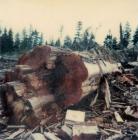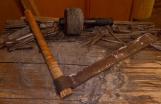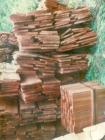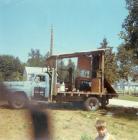1
Shakes and shingles were typically made from Western Red Cedar and were cut from salvage logs left in the forest from previous logging operations or from selective logging of dead trees. Cedar was a popular product because it contains a natural preservative which makes it long lasting.Shakes were split on both sides, typically 38-60 cm ( 15-24 in) long and 1.27 cm (1/2 inch) thick. Shingles were sawn on both sides 46 cm (18 in ) long and 1.5 cm (3/8 in) thick. Shakes and shingles were generally used for roofing and siding on buildings.
3
In the early days, the cutting, splitting and packing of shakes took place in the bush. Swede, crosscut and handsaws were used to cut the logs into blocks. These saws were eventually replaced by power saws.4
A sawyer would buck the fallen log into 60 cm (24 in) blocks with straight cuts perpendicular to the grain which minimized waste and maintained product quality.The blocks would then be cut into quarters making them easier to handle. The block quarters were split into shakes using a froe and mallet.
6
The shakes were packed into bundles using a packing frame. The bundles weighing between 22-34 kg (50-75 lbs) were then packed out of the bush, often by hand, and loaded onto a truck.Making shakes in the bush was often a small family enterprise with the men sawing the logs and splitting the blocks while the women and children packed the bundles into the packing frames. The men would then pack the bundles out of the bush.
The bundles would be loaded onto railcars and shipped across Canada and the United States.
8
Portable shingle mills replaced the froe and mallet for making shingles. The portable shingle mill could easily be moved to wherever the logs were being harvested.Eventually permanent mills were set up. The waste products of bark and sawdust were disposed of in beehive burners. A small shingle mill with one saw could efficiently operate with four men.



